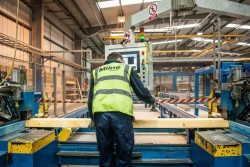John Smith, technical director at Stewart Milne Timber
Systems, discusses the benefits of offsite timber building systems in the face
of potential weather-enforced downtime on-site
While many of us are growing weary of being confined to our
homes during the pandemic, it has come with a greater appreciation of the
warmth, shelter and sanctity they can provide, particularly during the colder
months.
The industry has not been immune to the effects of the
Covid-19 pandemic. A recent report from Homes England revealed that, thanks to
disruption caused by subsequent restrictions, the delivery of housing
programmes decreased in the first half of 2020-21, compared with the same
period last year.
Similarly, a report by the House Builders Federation showed
that property completions were down by an average of 35% in 2020 and supply
statistics published by the Ministry of Housing, Communities & Local
Government last year were among the lowest quarterly figures that had been
produced in the series.
With the economic impact of the Covid-19 pandemic expected
to have a knock-on effect on demand for affordable housing – according to the
Local Government Association, the number of people on waiting lists could
exceed 2m this year – housing secretary Robert Jenrick stated that the
government intends to stick to its current target of 300,000 homes to be built
across every part of the country, in order to help the next generation to get
on to the housing ladder and the most vulnerable in society to find housing.
One million homes built over five years was always an
ambitious, but not insurmountable, target; however, in addition to the
complexities of Covid-19, winter brings further challenges.
Constructing well-performing homes, regardless of the
weather
With an acute housing shortage, industry cannot afford
weather-related delays throughout the winter months.
Among the many financial implications presented by weather
delays, including cost overruns for labour, equipment hire and materials, and
the subsequent disruption of cashflow, this allows very little leeway in
meeting building demands during winter, when the weather can debilitate sites.
There is a solution to constructing well-performing homes,
regardless of the weather, that stills adhere to strict social distancing
rules: offsite construction.
When the weather creates difficult building conditions, the
manufacturing of timber building systems can carry on uninterrupted – completed
offsite through factory facilities, which allow for safety measures like
physical distancing to be put in place – another added benefit from investing
in this material.
Offsite panelised construction is less labour intensive
on-site, requiring fewer personnel on the ground, unlike traditional building
methods. With an acute skills shortage in the UK, it presents a way for
construction to continue unimpeded, to high standards.
Requiring less heavy machinery and less energy, it provides
a more sustainable, environmentally friendly method of housebuilding, and with
a reduction in labour and costs associated with machinery hire, housebuilders
who opt for offsite construction benefit from both cost-effectiveness and
delivery capacity – essential in helping the industry meet government targets
to address the housing shortage.
Initiatives such as the AIMCH housing innovation project –
an industry-wide collaboration that aims to transform how homes are built – are
progressing the development of industrialised offsite solutions.
Through our work on the AIMCH project, trials have seen
plots erected without the need for scaffolding and pre-tiled roofs assembled on
site at ground level, reducing the need to work from height, as well as having
less labour on site, which is important in these times of social distancing.
Reaping the benefits of offsite construction
Financially, the accelerated build time of offsite
construction delivers results, providing a quicker return on capital outlay and
lower site preliminaries expenditure. Evidently, there are health and safety
advantages to working offsite and indoors, where the risk of working at height
in adverse weather conditions can be problematic. Factory conditions are stable
no matter the weather, reducing potential hazards that can be faced by staff
on-site.
Across the UK, we have the capacity to produce around 10,000
offsite timber building systems per year. That ability to manufacture offsite
means we can build a typical detached plot between six and eight weeks quicker
than traditional brick and block construction. A further example of
construction time benefit would be a typical four-bedroom detached home, which
could be manufactured, transported, erected, wind-protected and made watertight
in as little as five days.
Although the UK’s construction industry is amid a robust
recovery from the effects of the pandemic, with housing the biggest driver of
construction growth, this momentum must be carried forward.
As the housebuilding industry perseveres throughout tiered restrictions and lockdowns, and companies re-examine their business strategies and models, it will become even more important to reduce building delays caused by adverse weather conditions. Offsite building does just that.
Original Source: PBC Today









